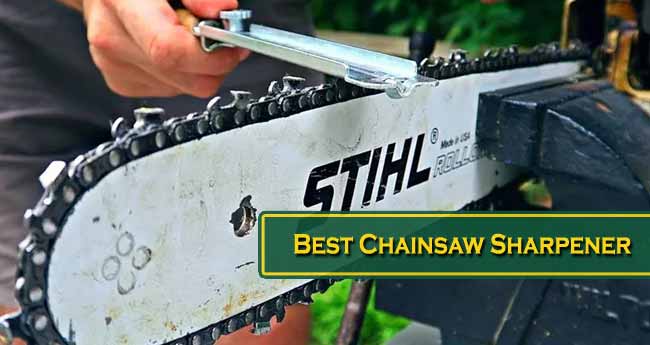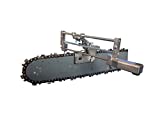A chainsaw is a woodworker’s best friend. It primarily helps in felling trees, cutting wood down to size, and sometimes, even with precision jobs. They are useful and deserve proper care and attention.
Finding the right chainsaw is crucial, but maintaining it is a whole different story. Some might think these mechanical saws are indestructible, but that’s not quite the real story. The sharp edges of the saw will dull in time or may be due to an accident like hitting rocks or accumulating the sap from softwoods.
In this review, we will determine which one is the best chainsaw sharpener among the different established and relatively new brands.
|
Image |
Name |
Editor’s Rating |
Price |
|---|---|---|---|
|
|
Stihl 2 in1 Easy File |
5 out of 5 |
|
|
|
Buffalo Tools ECSS Electric |
5 out of 5 |
|
|
|
Katzco Chainsaw Sharpener File Kit |
4.5 out of 5 |
|
|
|
Granberg Bar-Mount Chain Saw Sharpener |
4 out of 5 |
|
|
|
Oregon 120 Volt Bench/Wall Mounted Saw Chain Grinder |
4.5 out of 5 |
Do Chainsaw Sharpeners Work?
Before jumping into our chainsaw sharpeners reviews, let us try to determine if you would rather sharpen your chainsaw or replace the teeth entirely.
For Safety
If your chainsaw doesn’t cut, then you run the risk of breaking the instrument, and you might even injure yourself.
The majority of professional woodworkers and people who use chainsaws will recommend sharpening your blades every so often to keep them sharp and precise.
Saves Money
A lot of people believe that once a chainsaw blade becomes dull, you just toss it in the bin and buy a new one. But that is not entirely the case. Sharpening works for the chainsaw.
Of course, one day, when you’ve leveled out the blade due to filing and sharpening, you will need to replace it altogether, but sharpening your chainsaw will help save you money and the effort in changing out the blade.
So, you must invest in the best chainsaw sharpeners for your tools. There are plenty of choices around, and you will see some of the sharpeners in this review. And you will see more still when you search around for chainsaw teeth sharpener reviews.
Various Options
There are manual and automatic options. You can pick and choose the ones that fit your preference. After all, maintenance is something that will keep your tools pristine even after years of use and abuse.
Of course, you will need to weigh out the pros and cons of each one and see which works best for your tools and your workflow. But like what we’ve mentioned, there are plenty of choices around, and it won’t be a chore picking the right one for you.
It is easier and faster than you think when you have the right tool for you. Sharpening your chainsaw is a simple task that proves beneficial and helpful to your tools and can help save you a penny for a rainy day.
10 Best Chainsaw Sharpener Reviews
These ten sharpeners come in many shapes and sizes that will fit everyone. You will surely find one that will be your partner in keeping your chainsaw sharp and awesome.
1. Stihl 2 in1 Easy File
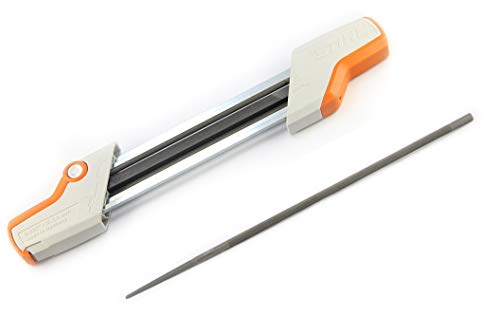
First of the list is an innovation from one of the leaders in power tools. Stihl developed a practical tool for sharpening chainsaw chains. This has a simple mechanism that makes it the best manual chainsaw sharpener today.
The 2 in 1 sharpener is a combination of a sharpening tool and depth gauge.
It has lines etched on it to help you line up with the bar and keep the bar consistent with the angle you want to file your chainsaw tooth. Just make sure you’re using the right files for the right chain sizes.
If you’re using this tool for the first time, line it with the angle your chain is gearing toward and run it across. Count the number of times you ran it until it’s sharp and then do the same with the rest of the teeth with the same number of filing.
Take note that you cannot change the round files that come with it. They come in a standard of .325 or 3/16″. This is pretty much the average size for chains, which leaves little room for worry. But it will always be good to check your chain before purchasing or using this chain saw sharpener.
What this does is that it files the rakers at the same time with the teeth. This way, you have an even height for both, which makes cutting faster. It also cuts down the time and effort to file the raker and tooth individually – definitely a time-saver.
Pros
Cons
2. Buffalo Tools ECSS Electric
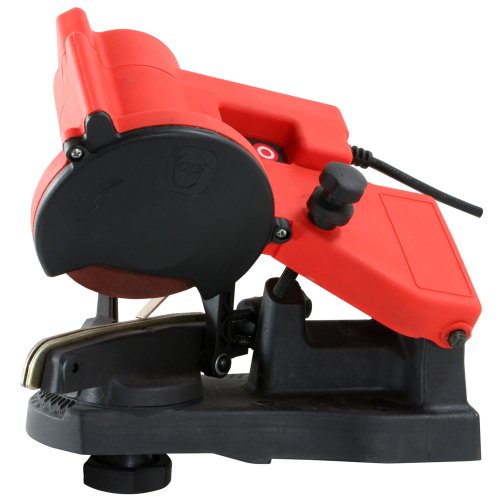
If you’re the DIY kind of guy and want a table-top chain saw sharpener, this one is something worth considering.
It plugs into the wall outlet and has about 4200 RPM grinding speed. You can mount it on a bench, vise, or even on a wall. This can save you time and money by sharpening your own saw.
Unlike the one from Stihl, which you can use on the fly, you will have several things to adjust in this tool before you can use it properly to sharpen your chain.
On top of the tool, there is a depth gauge that you can adjust to keep the grinding blade from digging into the chain.
You have to make sure that it meets the right angle at which your chain is going. And you can adjust this using the base of the tool. Find the right angle and lock it into place.
Before grinding, you also have to check the fine-tuning gauge to make sure where your chain is when grinding. It seems like a lot of work starting out, but once it is all set, you can grind one side with ease. When sharpening the other side of the chain, you have to adjust accordingly again.
Pros
Cons
3. Katzco Chainsaw Sharpener File Kit
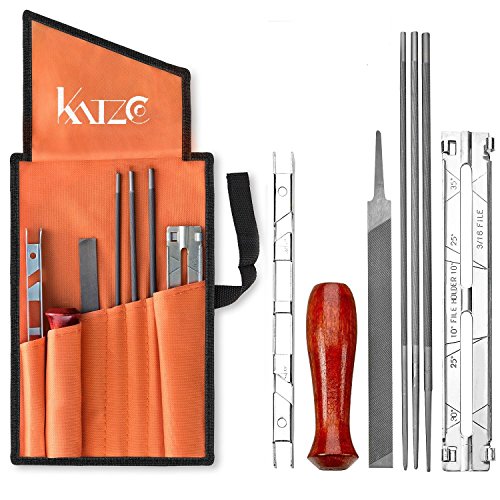
If you just want to sharpen your chainsaw blade the classic way, then this is the kit for you. It comes with a roll-up tool pouch, which is as old school as it can get.
It contains every file tool you will need to sharpen those teeth to get your chainsaw back to pristine and sharp condition. You don’t see a lot of sharpener of this variety nowadays, which makes them more desirable.
The portable kit includes a depth gauge, a beautiful hardwood handle, a flat file, three round files of 5/32″, 3/16″, and 7/32″ sizes, and a file holder.
All these fit snugly in the roll-up pouch, which allows effortless organization and portability for the owner.
If you have experience in sharpening chainsaw blades manually, these will be a breeze to operate. But if you’re just starting out and want to learn how to use them, there is a user manual and plenty of videos online to guide you in the process.
Overall, this kit is something you want to keep in your tool shed as a backup. These are no-frills and straight to the point files which can help you maintain and care for your chainsaw.
If you want to learn a new set of skills, this file kit will help you with it.
Pros
Cons
4. Granberg Bar-Mount
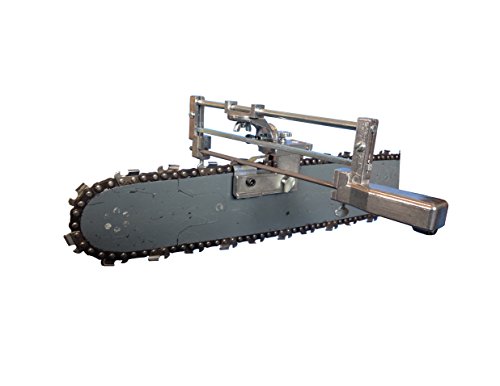
While these look like some torture devices from the middle ages, they are quite exceptional when it comes to sharpening your chainsaw.
This cast aluminum and zinc-plated tool can sharpen almost any blade and can mount onto any saw of any size. Its accuracy is something that it brags about. And its bragging rights stem from the fact that it takes its design roots from Germany, even though it’s made in California.
It maintains and sharpens your chain fast and easy once you’re all set. Due to its small size, you can bring it anywhere you need to go. So, this is ideal for anyone who travels and needs to prime their chain every so often.
The calibrated swivel guide markings help set and hold correct sharpening angles from zero up to 40 degrees. That’s enough to cover a wide spectrum of chainsaw blade types. You can also set the height of the file as well as the length of the tooth.
Just make sure that you also have the correct files with you as this bar-mount tool doesn’t come with any files in the package. Check with your local hardware store for the right files, and you’ll be just fine.
Overall, this is a simple precision chainsaw sharpener that you can use for a lot of years and service your blades once you’ve become accustomed to using it.
Pros
Cons
5. Oregon 410-120 Mounted Saw



You can say that this is an upgraded version of a mechanical chain sharpener. While the Buffalo mechanical chain is mostly made of plastic, the Oregon is mostly made of metal. So, you can’t expect this unit to be as cheap as its plastic counterparts.
This is one of the most acclaimed products in many electric chainsaw sharpener reviews. But, even if it is relatively more expensive than other sharpeners in this review, it does a lot that makes the price worth it.
You don’t need to do a lot of guesswork when using this sharpener. It has etched marks and symbols that will help with setting the proper height and angle for you to grind at.
It also has clear instructions and manuals available for quick reference. The brand has a nice YouTube channel where you can find almost all the information you need to get started using one of their tools.
Also, the package includes three wheels for sharpening 1/4″, 3/8″ Low Profile, .325″, .325, 3/8″, .404″, 3/4″ pitch chain, and depth gauge grinding. They also throw in a dressing brick and a quick template.
On the plus, it also has a chainsaw grinder for the depth gauge so that you can also fix them to match the cutting side. If you have extra money lying around, you should opt for this sharpener as it will last a long time and can grind as much as it needs to in your lifetime.
Pros
Cons
6. Timberline Chainsaw Sharpener



Don’t let its size fool you. It may be small, but it packs a nice punch when it comes to sharpening your chainsaw.
Made in Idaho Falls, it is made from high quality machined aluminum, which makes it light, portable, and durable to wear and tear.
To use this sharpener, you mount it on your chainsaw, and position it so that you can see one chain at a time. After that, lock it in place with the knobs below. Then move the adjustable wheel, which sets the chain lock. It keeps the chains from moving as you sharpen each lock individually.
Remove the tool is not required when sharpening the left-hand or right-hand side of the blade. It has two openings where you can insert the file to sharpen accordingly by turning it clockwise. However, never turn it in the opposite direction as it will not do anything.
For best results, do it at a slow and steady pace so that you can sharpen the blades evenly and effectively.
This is a great tool for novices as it doesn’t take a lot of measurement to set it in place. Just take note that it only sharpens at a 30-degree angle.
Pros
Cons
7. SDMS Chainsaw Sharpener



If you want a fast and easy way to sharpen your chainsaw blade, then this may be the answer to your prayers.
Why? You just have to mount it on your chainsaw and let it do the trick. Does it have the bearings to wear the best manual chainsaw sharpener crown? It sure does so.
This automatic sharpener is a simple sharpening tool made up of a housing, a sharpening stone, and a mechanism that allows you to operate the device. It can be used practically by anyone who can operate a chainsaw.
You simply mount it on your chainsaw and press it while the chain rotates, and it will sharpen the chain itself in a matter of seconds.
It does away with sharpening your chainsaw manually, which is tedious and time-consuming. It also keeps the user from going to a shop to get it sharpened. You can say that it’s almost like an automatic chainsaw sharpener.
In order to use this device, you have to adjust the rivet inside of it to fit the holes in your chainsaw. If your chainsaw only has one hole, you can remove the adjustable rivet to mount this device.
It can address different chain sizes without having to swap out the grinding stone. With its small dimension, it is also small in size and portable, so you can bring it where you need it to give your chainsaw blades a touch-up or a much-needed sharpening.
But be wary that it is made of plastic, and you’re dealing with a powerful motor. So, mounting it properly should be the main concern for anyone who will use it.
The sanding stone used is not anything you can find in the hardware store, so if you plan on using this in the long term, make sure to stock up on whetstones from the seller.
Pros
Cons
8. Husqvarna SharpForce
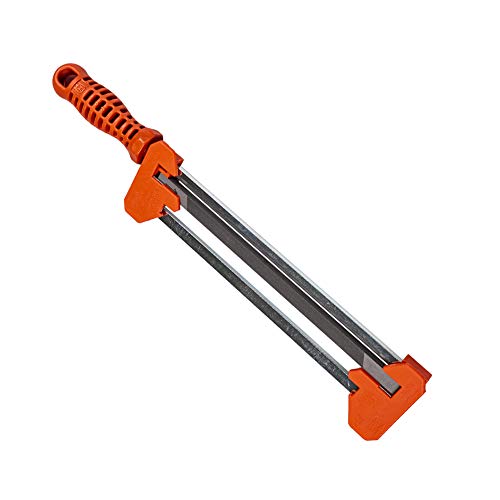


Like the sharpener from Stihl, this is another manual sharpener by a well-known tool producer who delivers high-quality garden and lawn tools.
This is an affordable and user-friendly sharpening tool compared to mounted ones. But that is not to say that it cannot perform as good, if not better than the other tools mentioned in this review.
It is ideal for beginners or novices that want to learn how to sharpen their own tools. The handy guide will allow for fewer mistakes and give the user a good feel of the right angle and depth on which to use the sharpener.
Since it is a manual and portable sharpener, it can easily be brought anywhere. If the user needs to work on a particular place that doesn’t have any outlet, this sharpener will do well to keep the edge of the chainsaw nice and sharp.
This tool is highly durable and easy to use. So, any novice will find it simple and effective in sharpening their chainsaw chain.
If you’re a homeowner who purchased a chainsaw for the occasional cutting of wood used for building a fire, this is an ideal accessory for your tool.
It has a user-friendly build that allows the user to easily adjust and manipulate it to get the job done.
On the other hand, its handle and some components are made of flimsy materials that may keep you from applying too much force in it.
Since it is also made from relatively lighter materials, it may also be prone to breaking if not handled correctly.
Pros
Cons
9. Blue Max 5655 Electric Bench Mount
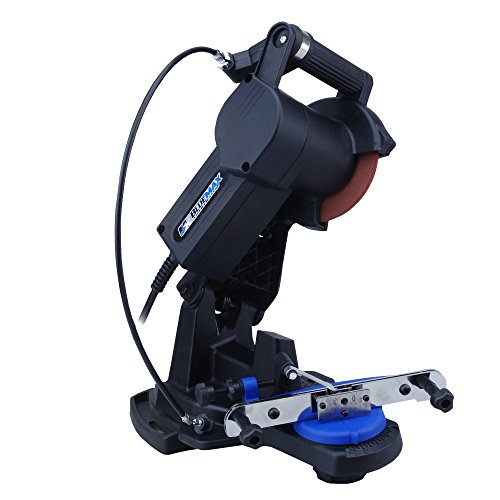


Much like any wall, vise, or bench-mounted chainsaw sharpener, this is a tool worth considering if you want an electric sharpener.
One thing that sets this tool apart from our previous electric chainsaw sharpener reviews is the brake that allows you to hold firmly to the chain as you are sharpening it.
The Blue Max 5655 can sharpen just about any chain size there is, with the same locking mechanisms and fine-tuning parts that allow you to precisely sharpen your chainsaw chains. It produces 85 watts of power, which is enough to sharpen chainsaw chains.
You can also grind the depth gauge with this sharpener. This will help in creating a better connection between your chainsaw chain and the material you are cutting. Thus, it enables a faster and more efficient process.
While sharpening, a newbie may find the Blue Max to be somewhat challenging. But learning how to use this will get easier as they use it regularly.
The adjustable feature allows it to be used up to 35-degree angles. This is great if you want your chain to have the best chain to material contact for a sharper chain and faster cutting time.
Only be aware that the steeper your angle on the chain is, the faster it will dull. It can also be easily fixed on the workbench or on a vise for easy access. This offers stability and even precision when working on your chainsaw chains.
Of course, if you fix this unit on a workbench, its mobility will be limited to the length of the power cord.
Pros
Cons
10. Sportsman Earth Series



This heavy-duty chainsaw sharpener will keep your chainsaw blades sharp as if a professional is doing the sharpening.
Sportsman Chainsaw Grinder is shipped with two 5.5-inch diameter chainsaw grinder, plus a 1/8 and 3/16-inch wheels and fits most brands and most common chain sizes – 1/4, .325, 3/8, and .404 inch.
Its motor spins the wheels at 3,000 RPMs, ideal for sharpening the edges of the chainsaw chain. As for the built-in work light feature, it helps in precise sharpening and maintaining the edge on your chainsaw.
The power output is 230 watts. But even with that power, it still maintains a quiet motor that puts out less than 85 decibels.
To operate this sharpener, you need to adjust a few fine-tuning knobs to make sure that the chain is properly set to the right angle and the right height for optimal sharpening.
You will want to save up a little more if you want this unit because it may cost you a little more than the other chainsaw sharpeners in this review.
While it may have limited mobility, you can depend on it to be sturdy enough to handle your chain sharpening needs.
But the price is well worth it if you purchase this because it is made from sturdy materials and metal components that will last a long time with proper use.
The time and effort you will put into learning how to use it and set the proper height and angle for it will be well worth it because of the result it will provide you for your chainsaw chains.
Pros
Cons
What to Look for When Buying?

As there are many options available for you around like the ones presented in this chainsaw sharpeners review, what are the key factors you should look for when buying one for your garage or shop?
Well, here are some that you absolutely need to know and consider if you want to own a sharpener in your home.
But before proceeding to the list, a word of advice: your sharpeners need care and maintenance too! Since we’re dealing with hard materials, it is not possible for something to retain its condition even after many times it has been used.
Simple measures can add up to big differences. Wipe the sharpener clean, make sure that there are no materials left that will damage or break your tools. Much like any other tools and devices, the proper care and maintenance will determine how long you can use them.
A clean and easily maintained sharpener will give a longer lasting edge and will serve you and your chains for a long time.
Electric or Manual Sharpener
The choice may seem to lean toward electric sharpeners in this head to head comparison, but there are things that you should know before brushing manual sharpeners on the side.
Manual sharpeners are easy to use and control. While the truth is that they are slower compared to electric sharpeners, this comes as an advantage to them because they are less prone to accidents due to less force and power to sharpen the blades.
Of course, you can’t beat something that will allow you to finish a 45-minute job in as little as 10 minutes.
A factor you also should consider when choosing between the two is the price. The electric models cost more than double the price of manual sharpeners.
Ultimately, it all boils down to preference – different strokes for different folks. There are advantages to either type of sharpener, and some people can easily adjust and even welcome some of the challenges that either may pose.
Angle and Height
Novices should take note of understanding the angles and heights of different chainsaws.
Every tooth of the chainsaw has a defined height and angle in which it operates. You should know this because you need to consider them when filing them back to sharpness.
Different tooth heights require different sizes of files. Angles, likewise, need to be considered if you want a really sharp edge on your chainsaw chain.
All sharpeners have angle markings, but not all can handle all tooth heights or angles. This is something that you need to familiarize yourself with because these are standards that you need to follow in order to properly set up and sharpen your chain.
Find out the information about your chain and choose the one that fits those requirements accordingly.
In this review, there were disc-type sharpeners, which were mostly wall or workbench mounted. This may add to their sturdiness but may compromise their adjustability a little when setting the angle or height.
On the other hand, a hand-held or mounted sharpener may be easy to control, but it may work counter productively when you want a precise shape and angle every time.
Portability
The last one to consider is if you want a portable sharpener or if you will be just leaving one at home. This depends on where you work and how you use your chainsaw.
For homeowners who mostly use their chainsaw for maintenance and for few occasions, they may not need to bring their sharpeners wherever they go, unlike workers who go to woodlands and cut trees and wood almost every day.
Some models require electricity to function, and others just need elbow grease to make it do its job. So, it’s up to you to decide which one will fit your bill just right.
What’s the Best Angle to Sharpen a Chainsaw?
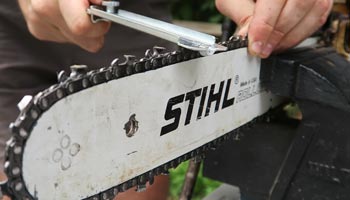
Sharpening a chainsaw is not rocket science. Anyone with the right amount of skill and patience and determination can do it.
But of course, you still have to factor in some technical aspects in order for you to be successful in your endeavor.
One of the most crucial things you should consider when sharpening the chainsaw chain is the angle.
There are many thoughts that come into play when this is discussed, and we will see which ones are best for your situation.
Most standard chains are sharpened at 25-35 degrees for cutting wood. This is because the materials are dense and need a steeper angle to cut through.
Start with 30 Degrees
Generally, it is accepted that you sharpen your chainsaw between these angles, with 30 degrees being the most ideal because it is half-way. With this angle, you can easily go through softwoods and power through hardwoods without much effort on your part.
Aside from performing better, having a set angle also allows for faster sharpening. Since you don’t need a lot of adjusting when you have a 30-degree angle sharpening point, you can sharpen more chains with less time.
A 30-degree angle also lends for sharper teeth, which means faster working time and less effort in cutting.
But there’s a small caveat. Most experienced chainsaw users say that anything with more than a 30-degree angle will dull faster compared to a lower angle like 10 degrees.
With a 10-degree angle, your chainsaw runs much cooler since it doesn’t bite on the material as much.
So, which is the best angle to grind and sharpen a chainsaw?
A 30-degree angle will help you with your task faster and will also help to optimize the power of your chainsaw. It will significantly reduce the time you consume for sharpening your chainsaw teeth.
Frequently Asked Questions
1. What Size File Should I Own?
You should own at least three round file sizes: 5/32”, 3/16”, and 7/32” sizes.
2. Do I Need to Clean the Chain Before Sharpening?
Ideally, yes. Some wood has sap, and these can make your chain hard to use. Also, a clean chain is easier to sharpen because you can see your progress as you grind the edges.
3. Do I Need to Sharpen the Depth Gauge Along with the Teeth?
Not necessarily. The idea is to make the depth gauge a little lower than the teeth for optimum performance. This is because the depth gauge helps position the teeth so that it can bite the right size into the wood for easier cutting.
4. Do All These Kits and Models Work for All Chainsaw Brands?
It depends and varies on the specification of the chainsaw brand. The thing that should be considered the most are the angle and the height of the chain.
5. What if the File Doesn’t Fit My Chain?
Some models come with different sizes of files. If you’re starting as a novice, it will benefit you if you are familiar with the differences of chain size and angles.
Final Words
We hope that you found this chainsaw sharpeners review helpful in determining which is the best chainsaw sharpener to purchase.
To choose the best sharpener for you, make sure you understand the requirements needed for you to sharpen your chainsaw chain correctly.
Recommended To Read:
- When chainsaw was invented?
- What is the exact measurement to tight the chain?

